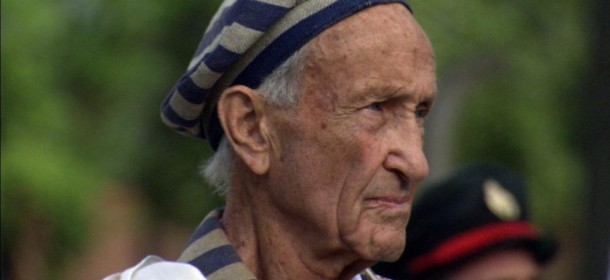
Dir.: Claire Ferguson; Documentary; UK/Austria/Poland/USA 2016, 78 min.
Between 2003 and 2016, producer Llion Roberts travelled the world to interview survivors of the Shoah. In 2014 he collaborated with director Claire Ferguson (Concert for Bangladesh Revisited) on a collection of interviews for Destination Unknown, a living testimony of twelve survivors – five are no long with us, making this documentary even more salient.
Relying on the testimony of the witnesses alone, and archive films from before and after the war – as well as harrowing newsreels from the liberation of the camps – it becomes clear that the survivors faced their ‘Destination unknown’ twice: when arrested and transported in overcrowded cattle trains, they had no idea where there were heading. And after their liberation from the Camps, fresh anxiety over their future must have overwhelmed them again. It’s impossible to imagine more disparate entities in comparing the archive clips of ghetto life before 1939, with the inhuman conditions of the camps, and the secure middle-class environment in the USA, Canada, Israel or other countries, captured on 8mm films. These women and men have faced different universes in one lifetimes. Clearly, all survivors should have their harrowing life stories told, and while words mean so little from the safety of our own perspective, watching the film help to brings to life their courage and suffering.
Edward Mosberg, born 1926, regularly visits Concentration Camps, together with his wife Cecile, another survivor. Both lived in the Krakow ghetto, after which Cecile was imprisoned in the camps of Plaszow, Auschwitz-Birkenau (surviving two death-marches), Bergen-Belsen, Gelenau and Mauthausen, where she was liberated. Edward Mosberg survived the Plaszow, Mauthausen and Linz camps. In Mauthausen he had to carry heavy stones up stairs, if he’d have stopped or fallen, the Germans would have pushed him to his death over the cliffs, or shot him. He is the sole survivor of a family of 26; his mother was gassed in Auschwitz, his two sisters were shot – together with 7000 young women, their bodies thrown into the Baltic Sea by the Germans a day before Stutthof Concentration Camp was liberated. Edward and Cecile were married in Belgium in 1951 and emigrated to the USA shortly afterwards. They have three daughters.
Marsha Kreuzman was born in Krakow in 1923. In 1940, her family was transported to the Majdanek Camp, her mother was shot and killed. Marsha had promised her to look after her father and brother. After that, the Kreuzmans were moved to the Plaszow camp, and Marsha remembers “that it was the only camp without a crematorium. They had other ways to kill us.” In 1943 Kreuzman’s father was found in a ditch, and she had to watch, as he and other prisoners were lined up and shot. In May 1944, her brother did not pass the ‘selection’ and was sent to Auschwitz, where he was murdered. Early in 1945, Marsha Kreuzman and other survivors were marched to Auschwitz, the march took five days and four night under brutal conditions. After Auschwitz, she survived another ‘death march’, this time to the Bergen-Belsen camp. Of the over 5000 inmates, who set out in Auschwitz, only 100 survived – Marsha was one of them. But her ordeal was not over: she was sent to the Camps of Flossenburg and finally Mauthausen, until she was liberated on May 5th 1945 by the US army: near death, she was weighing 34 kg.
Stanley Glogauer, who died in 2013, was taken from the ghetto to Auschwitz and separated from his mother and sisters. Later he learned from an uncle, that they had been murdered. When Stanley’s father broke a leg, he was sent to the infirmary, which was more or less the same as a death sentence. Stanley himself was very fit, and caught the attention of Dr. Josef Mengele. On Mengele’s order, his skull was opened with a chisel, without anaesthetic – to test if such operation were possible on the battlefield. Whilst he was still conscious, they sewed the skull up over the perforated skull and declared “the operation a success”. Asking the orderly, Bruno, to dispose of Stanley’s body, the “man of science and culture left, to listen to Wagner”. Bruno, a Czech, who was probably in the camp for being a homosexual, nursed Stanley back to health and helped to get him job, which made his eventual survival possible. Stanley had to ‘greet’ the newly arrived camp inmates, and take their possessions from them. He also told the mothers, to give their babies to the older women of the camp staff, since they would otherwise be killed immediately. Some mothers held on to their babies and died with them, others, chose a deadly lottery, leaving their children with Stanley and his fellow inmates, giving them a glimmer of hope.
The last word should go to Helena Sternlicht, one of the survivors of the famous Schindler list. “Everybody had a choice. Amon Göth [the commander of the Plaszow Camp, who was executed in 1946] chose to kill, Oskar Schindler chose to save lives”. Sternlicht is one of those survivors who continued to fight to keep the memory of the Shoah victims alive. Others did not want to “burden their families with their sadness, and kept quiet.” But none of them could ever sleep soundly at night and be sure of what would await them on the morrow. AS
ON RELEASE AT SELECTED CINEMAS FROM 15 JUNE 2017